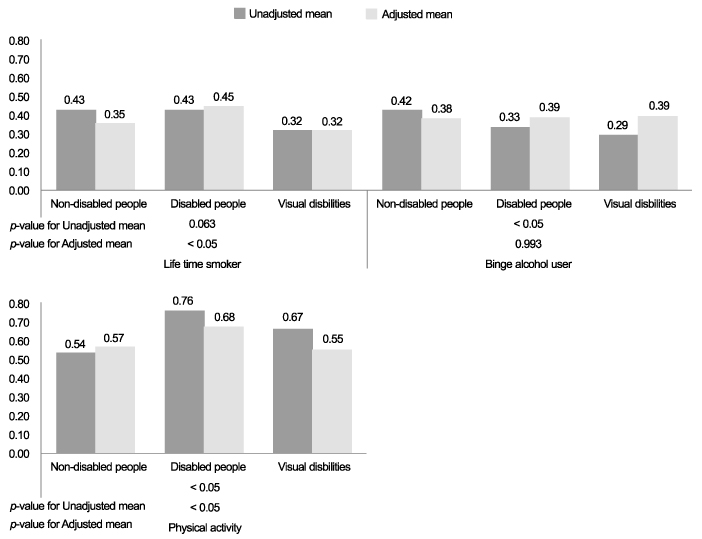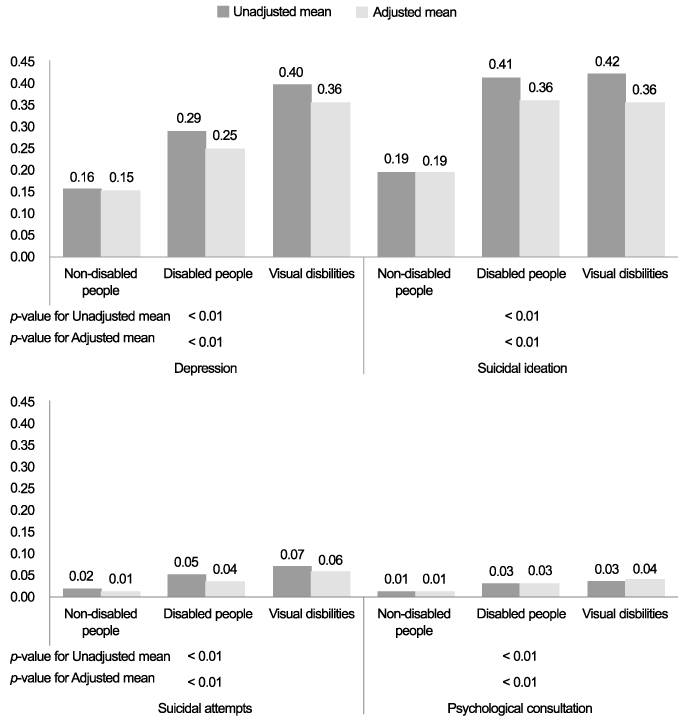J Korean Ophthalmol Soc.
2012 Dec;53(12):1870-1878. 10.3341/jkos.2012.53.12.1870.
Preventive Health Examination, Health Behavior, and Psychological Health in Visual Disabilities
- Affiliations
-
- 1Department of Ophthalmololgy, Gangnam Severance Hospital, Yonsei University College of Medicine, Seoul, Korea. shhan222@yuhs.ac
- KMID: 2216404
- DOI: http://doi.org/10.3341/jkos.2012.53.12.1870
Abstract
- PURPOSE
To better understand visual disabilities via preventative health examination, health behavior, and psychological health.
METHODS
The preventative health examination, health behavior, and psychological health records of 4,724 participants over the age of 40 who completed the third Korean National Health and Nutrition Examination Survey (KNHANES III) were analyzed. The participants were divided into 3 groups for analysis: subjects without disabilities, subjects with disabilities but without visual disabilities, and subjects with visual disabilities. The unadjusted mean and the adjusted mean for which socioeconomic factors were adjusted were calculated.
RESULTS
In the preventative health examination there were no differences between the 3 groups except for a statistically significant increase in the number of cholesterol check-ups in the visual disability group. In the health-related behavior analysis, lifetime smoking and routine physical activity were similar between the visual disability and no disability group, however, these factors were greater in the disability without visual disability group. The analysis of psychological health revealed that major depressive symptoms, suicidal ideation, suicidal attempts and psychological consultations were greater in the disability without visual disability and the visual disability groups compared to the participants without disability. However the overall number of psychological consultations was low.
CONCLUSIONS
There was no difference in the frequency of preventative health examinations between each group. However, there was an increase in the prevalence of psychological problems in subjects with visual disabilities compared to subjects without disabilities and subjects with disabilities but without visual disabilities. Thus, ophthalmologists should consider psychological aspects when dealing with patients with visual disturbances.
Keyword
MeSH Terms
Figure
Reference
-
1. Resnikoff S, Pascolini D, Etya'ale D, et al. Global data on visual impairment in the year 2002. Bull World Health Organ. 2004. 82:844–851.2. Nyman SR, Gosney MA, Victor CR. Psychosocial impact of visual impairment in working-age adults. Br J Ophthalmol. 2010. 94:1427–1431.3. Brody BL, Roch-Levecq AC, Gamst AC, et al. Self-management of age-related macular degeneration and quality of life: a randomized controlled trial. Arch Ophthalmol. 2002. 120:1477–1483.4. Ministry of Health and Welfare Korea. National cancer screening programmes guidelines. 2006. Seoul: Ministry of Health and Welfare.5. DiNuzzo AR, Black SA, Lichtenstein MJ, Markides KS. Prevalence [correction of prevalance] of functional blindness, visual impairment, and related functional deficits among elderly Mexican Americans. J Gerontol A Biol Sci Med Sci. 2001. 56:M548–M551.6. Lee K, Lim HT, Park SM. Factors associated with use of breast cancer screening services by women aged ≥ 40 years in Korea: the third Korea National Health and Nutrition Examination Survey 2005 (KNHANES III). BMC Cancer. 2010. 10:144.7. Kwon YM, Lim HT, Lee K, et al. Factors associated with use of gastric cancer screening services in Korea. World J Gastroenterol. 2009. 15:3653–3659.8. Boslaugh SE, Andresen EM. Correlates of physical activity for adults with disability. Prev Chronic Dis. 2006. 3:A78.9. De Leo D, Hickey PA, Meneghel G, Cantor CH. Blindness, fear of sight loss, and suicide. Psychosomatics. 1999. 40:339–344.10. Reinhardt JP. The importance of friendship and family support in adaptation to chronic vision impairment. J Gerontol B Psychol Sci Soc Sci. 1996. 51:P268–P278.
- Full Text Links
- Actions
-
Cited
- CITED
-
- Close
- Share
- Similar articles
-
- Psychological Well-being, Perceived Health Status, and Health Promoting Behavior of Clinical Nurses
- Predicting and Understanding School-Age Children's Visual Health Behavior
- Preventive Behavior and Health Belief about Hepatitis A of Adults in their Twenties to Thirties
- The Relationships of Patient Learning Needs and Health Promoting Behavior, Health Concept in Women with Disabilities*
- Relationships between Knowledge, Attitude and Preventive Health Behavior about Cancer in University Students





